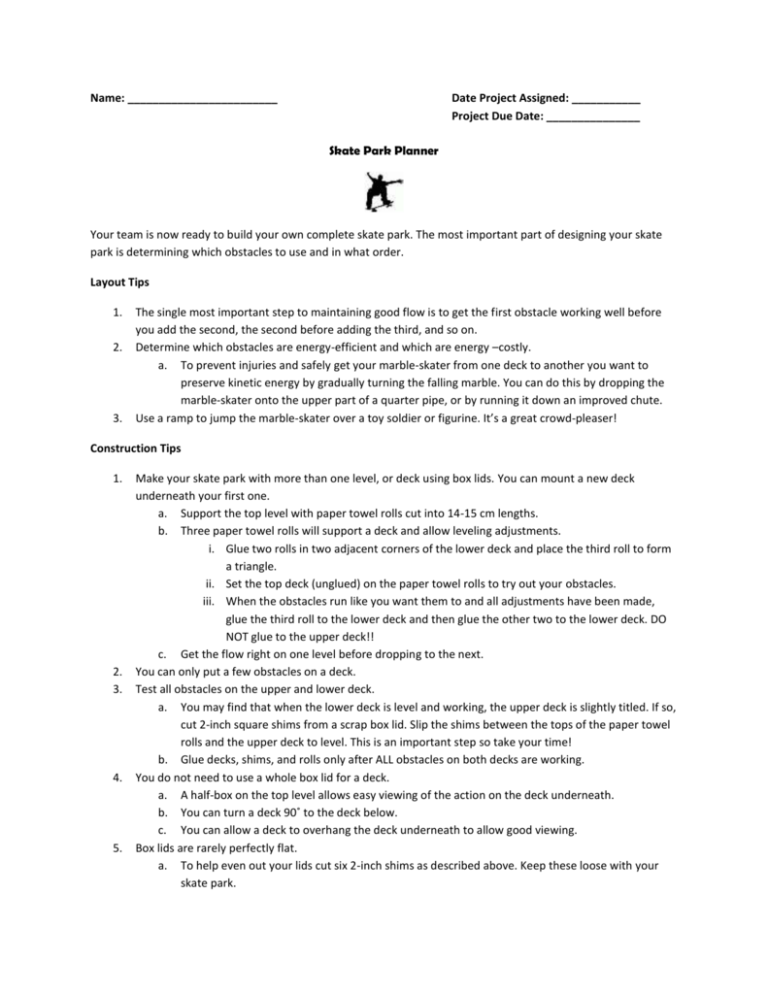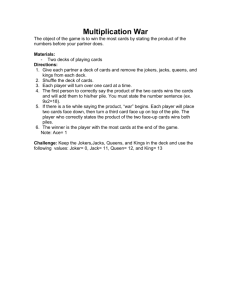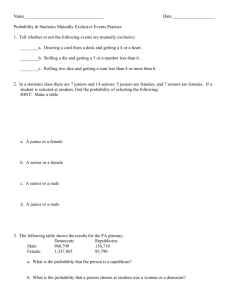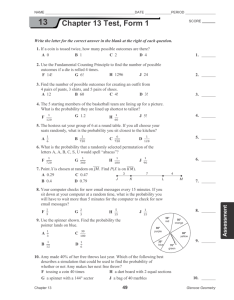Skate Park Planner
advertisement

Name: ________________________ Date Project Assigned: ___________ Project Due Date: _______________ Skate Park Planner Your team is now ready to build your own complete skate park. The most important part of designing your skate park is determining which obstacles to use and in what order. Layout Tips 1. 2. 3. The single most important step to maintaining good flow is to get the first obstacle working well before you add the second, the second before adding the third, and so on. Determine which obstacles are energy-efficient and which are energy –costly. a. To prevent injuries and safely get your marble-skater from one deck to another you want to preserve kinetic energy by gradually turning the falling marble. You can do this by dropping the marble-skater onto the upper part of a quarter pipe, or by running it down an improved chute. Use a ramp to jump the marble-skater over a toy soldier or figurine. It’s a great crowd-pleaser! Construction Tips 1. 2. 3. 4. 5. Make your skate park with more than one level, or deck using box lids. You can mount a new deck underneath your first one. a. Support the top level with paper towel rolls cut into 14-15 cm lengths. b. Three paper towel rolls will support a deck and allow leveling adjustments. i. Glue two rolls in two adjacent corners of the lower deck and place the third roll to form a triangle. ii. Set the top deck (unglued) on the paper towel rolls to try out your obstacles. iii. When the obstacles run like you want them to and all adjustments have been made, glue the third roll to the lower deck and then glue the other two to the lower deck. DO NOT glue to the upper deck!! c. Get the flow right on one level before dropping to the next. You can only put a few obstacles on a deck. Test all obstacles on the upper and lower deck. a. You may find that when the lower deck is level and working, the upper deck is slightly titled. If so, cut 2-inch square shims from a scrap box lid. Slip the shims between the tops of the paper towel rolls and the upper deck to level. This is an important step so take your time! b. Glue decks, shims, and rolls only after ALL obstacles on both decks are working. You do not need to use a whole box lid for a deck. a. A half-box on the top level allows easy viewing of the action on the deck underneath. b. You can turn a deck 90˚ to the deck below. c. You can allow a deck to overhang the deck underneath to allow good viewing. Box lids are rarely perfectly flat. a. To help even out your lids cut six 2-inch shims as described above. Keep these loose with your skate park. b. Each time you set up your park, place the shims as necessary under the two corners on one short side of the box between the box and the table, and under the middle of the opposite short side between the box and table. The Recorder should note the number and position of shims on the Mechanics Log so you don’t waste time trying to level your park each class. Scoring 1. Calculating Flow. a. Determine the Point Value of each obstacle by referring to the chart below. Obstacle Group Chutes Turners Launchers b. 2. Obstacle Chute Improved Chute Full Pipe with Chute Quarter Pipe Street Spine with Catcher Pyramid With Turn Ramp Fly Box Point Value 2 2 5 3 3 4 4 4 Start by taking the point value of the first obstacle you use and adding or multiplying to the point value of the second obstacle you use. i. Add the point value of obstacle 1 if the marble-skater stops and you have to pick it up and place it on Obstacle 2. ii. Multiply the point value of obstacle 1 if the marble skater flows onto obstacle 2. Penalties for Injuries. Your team will lose point for injuries. a. An injury is declared if the marble-skater: i. Flies off an obstacle and drops to the bottom of the box ii. Smashes into an obstacle iii. Falls out of the flat box b. The penalty of an injury equals triple the point value of the obstacle. (for example, a marble skater falls off a street spine (point value of 3), the penalty is minus 9 points on the final total score. Deciding on Obstacles 1. 2. 3. 4. Determine how much construction cash your team earned. Amount: __________ Look at the obstacle pictures on page 7 in your Student Guide. a. Mrs. Orihuel has a ramp, flybox, pyramid, and full pipe for you to experiment with to help you decide which obstacles you want to use. Remember, you already have a chute, improved chute, quarter pipe, and street spine with catcher. b. Make sure you can afford the obstacles you want to purchase. Turners are used to change the direction of the marble skater. Use these obstacles to turn the flow on a deck (box lid). Tipping the obstacle slightly or placing it at an angle will help with the turns. Ramps. Ramps are used to change the vertical direction of travel of your marble-skater. You can use a ramp to launch the marble-skater into the air. This is how you will get it up onto a new obstacle. Ramps can also be used to catch a dropping marble-skater. 5. When your team has decided which obstacles you want, Complete the “How Many” and “Total Cost” columns in the chart below. Obstacle Group Chutes Turners Launchers 6. 7. Obstacle Chute Improved Chute Full Pipe with Chute Quarter Pipe Street Spine with Catcher Pyramid With Turn Ramp Fly Box Point Value 2 2 5 3 3 4 4 4 Cost How Many Total Cost $50 $100 $250 $150 $150 $200 $200 $200 Total Construction Cash you will be spending: $ ____________________ When you have completed the 4 steps above your Architect should raise their hand and Mrs. Orihuel will check that your math is correct and that you can afford to buy what you listed. If it is correct, Mrs. Orihuel will initial your plans. Constructing & Repairing Additional Obstacles 1. 2. Engineers gather materials needed. Construct obstacles working in pairs so you can build two obstacles at the same time. Assembling and Testing the Skate Park 1. 2. 3. HINTS to keep in mind as you assemble your skate park. a. Always work in sections. Get the first section working and glued before starting the next section. b. Roll the marble-skater over and over until the obstacle works consistently. c. Adjust your obstacles so that the marble-skater flows from one to the other. Recorder must complete Mechanics Log as you create and test your obstacles. a. Note any problems you have making adjustments under OBSERVATIONS b. Note how (or if) you solved the problems on the SPECULATIONS and CONCLUSIONS side. The following questions should guide you in understanding HOW the obstacles work. EVERY member of your team MUST be able to answer these questions: a. Where is the original energy transferred to the marble-skater? b. From where did the original energy come from? c. Describe where Potential Energy and Kinetic Energy are being traded back and forth. d. Describe the point(s) where and how you reduced marble-skater hopping. e. Explain the relationship between big changes in direction and hopping. Tell why they are not good. f. Explain what is happening when friction slows a rolling marble-skater. g. Explain what your team did to minimize kinetic energy due to friction. Scoring Your Park 1. 2. 3. Fill out the Skate Expo Score Sheet a. There are 6 rows of 9 boxes. b. On the first row, write the value of each obstacle in order in each box. (page 6 in your Student Guide) c. Copy these numbers in the same order in the 5 remaining rows. You will run your marble skater 6 times and can choose the best run for your top score. a. If the marble skater flowed from one obstacle onto the next, put an “X” symbol on the line between the point values. If it needed to be reset (picked up), put a “+” symbol. Make adjustments to your park as needed. Skate Park Expo 1. 2. 3. Oral Presentation a. Each team will have 2 minutes to introduce their working skate park model, explain their design, and make their’ “pitch as to why investors should choose their design. b. Take turns talking about what’s happening as the marble-skater approaches, rides through, and rolls out of each obstacle. Use the physics vocabulary; potential energy, kinetic energy, friction, hear, and inertia. Remember what you learned about Conservation of Energy and Newton’s First Law. Demonstration a. Run the marble-skater through the park 6 times. b. Teams may take 2 minutes in between runs to make minor adjustments with shims and tape, but no glue. c. Teams must complete the Skate Expo Score Sheet after each run. d. Select the highest score of the six tries. Highlight the score. Evaluation a. Mrs. Orihuel will award your team points for your oral presentation using two rubrics. i. Rubric 1: Focuses on Content ii. Rubric 2: Focuses on Organization and Presentation Style b. Class members will act as investors. c. Investors will award Investment Points for your skate park design, safety, presentation, and advertisement. d. Take Final Assessment Awards 1. Awards will be given for: a. Park(s) earning highest Investment Points b. Park(s) having Original or Challenging Obstacle Courses c. Team(s) having great presentations d. Team(s) having highest cooperative group score







